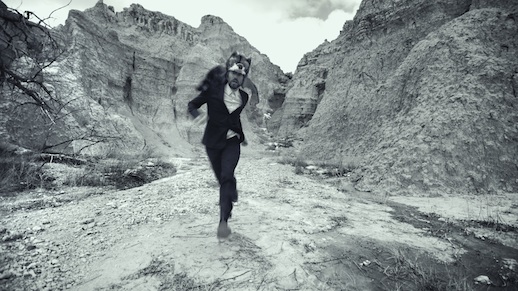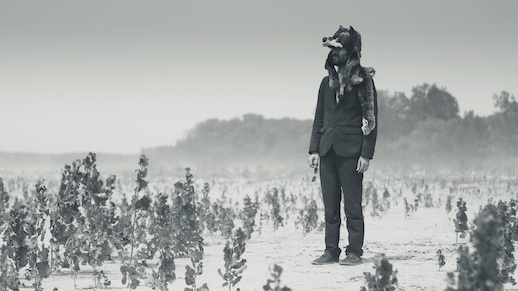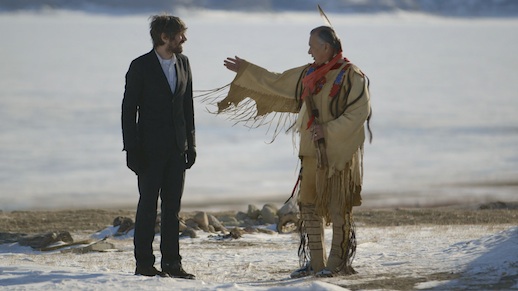American Interior by Gruff Rhys
Hamish Hamilton, hardback
Review by Richard King
‘One summer when Heat Moon and I were walking the ancestral grounds of the Osage near the river of that name in western Missouri, we talked about bloodlines. He said ‘each of the people from anywhere, when you see in them far enough, you find red blood and a red heart. There’s a hope.’
Blue Highways William Least Heat-Moon
In 1978 William Least Heat-Moon drove a half ton Econoline van across thirteen thousand miles of the smaller roads of America. These routes gave the record of his journey its title and were coloured blue on early maps of America in order to differentiate their status from the main trade roads that were marked in red. A resident of Missouri and descended from the once feared Osage tribe, Least Heat Moon was born William Lewis Trogdon. His trans-American road trip was precipitated by the breakdown of his marriage and the loss of his job, and in preparation for the journey he changed his troubled current identity for one from the past. His father’s ancestral name was Heat Moon, his elder brother’s Little Heat Moon and thus Trogdon, soon to become an itinerant rather than a recently laid-off teacher, was transmuted into Least-Heat Moon.
Aware that he was in need of a shared sense of purpose and some form of spirit guide, Least-Heat Moon also renamed his Ford van ‘Ghost Dancing’:
‘Ghost Dancing, a heavy handed symbol alluding to the ceremonies of the 1890s in which the Plains Indians, wearing cloth shirts they believed rendered them indestructible, danced for the return of warriors, bison and the fervour of the old life that would sweep away the new’
Published in 1983 Blue Highways was an antidote to the two-year-old Reagan presidency. It was a despatch from a never-ending frontier, one that ran the length of the border between the tensions of the past and the encroaching neuroses of that decade’s permanent Morning In America. As he set off from the banks of the Missouri, Least Heat-Moon was attempting to escape his present day difficulties and had little concern about his final destination. The book’s subtitle makes clear that the three-month road trip through a succession of small towns proved to be a deeper experience than he had initially anticipated. Rather than a circular drive across the continent, Blue Highways was, Least Heat-Moon insists, a journey ‘into America’.
American Interior recounts Gruff Rhys’ own search for ancestral bloodlines and red hearts along the Missouri. A journey he undertakes with the intention of discovering more about the life of one of his ancestors, John Evans, who for much of American Interior is Rhys’ own dancing ghost.
In 1792 John Evans from Waunfawr, a hamlet in North Wales near the stronghold of Caernarfon, embarked on a seven week sea voyage to Baltimore. Once he had landed in America his mission was to locate and verify the existence of the Madogwys, a lost tribe of Welsh speaking First Nation Americans thought to be descended from Madoc, the Welsh Prince who is said to have discovered America in 1170 around three hundred years before Columbus.
The Madogwys had become identified with the Mandan tribe of the Upper Missouri River, in part because the bull boat used by the Mandan for fishing was said to resemble a Welsh coracle.
Evans had been encouraged to undertake his journey while under the influence of Iolo Morganwg, an agitator, mythographer, laudanum user and literary celebrity of the exiled Welsh community in late eighteenth century London. Morganwg was a charismatic speaker who regularly undertook literary forgeries and whose use of opiates doubtless encouraged his belief in the Madogwys. One of his most notable achievements was the creation of the Gorsedd y Beirdd or Gorsedd, the neo-druidic assembly of bards that survives, indeed thrives, to the present day as one of the centrepieces of the annual National Eisteddfod.
It is easy to understand how John Evans, an orphan at twenty-one, displaced and impoverished in London fell under Morganwg’s spell. Nor was Evans alone in being smitten by Morganwg’s bardic revivalism, in her problematic English translation of the Mabinogion, Lady Charlotte Guest treated several of Morganwg’s forgeries as though they were authentic source material. For many of the Welsh diaspora in London, Iolo Morganwg had become as much of a folk hero as those created by his opiated imagination.
After disembarking in Baltimore Evans spent the subsequent four years crossing the continent northwards in search of the Mandam and, he still believed with complete sincerity, the discovery of the descendants of the Madogwys. His journey included an eighteen hundred mile passage along the Missouri including its southern basin where he proceeded unharmed by Least Heat Moon’s ancestors, the fierce Osage and Kansa nations, and was left instead to map the region with a sextant and compass. Although self-trained, Evans was an excellent cartographer and his original maps of his journey were later used by the Lewis-Clark expedition.
After years of fever, poverty, espionage and on-the-hoof cartography Evans finally reached the Mandan and experienced the benevolence and hospitality for which they were famed. It is there among this kindly people that he realises that a lost Welsh nation could never have existed and he returns down the Missouri to New Orleans where he dies of a fever and a broken heart aged twenty-nine.
Gruff Rhys undertook an Investigative Concert Tour to follow the route taken by Evans to the Mandan and American Interior is his account of this retracing. As the book’s travelogue develops it becomes clear that American Interior is an act of pilgrimage and as Rhys describes his experiences along the Missouri we begin to understand that, although he may never have found the Madogwys, perhaps John Evans himself became the sole member of this imaginary lost tribe.
Throughout the book Rhys switches between a typically self-deprecating account of the Investigative Tour, John Evans’s life story and a nuanced and respectful account of his time spent among the modern day inhabitants of the Missouri. As American Interior reaches the great river this third narrative element becomes the focus of the book and Rhys marks the end point of John Evans’ journey by spending a reflective period among the contemporary Mandan. He recounts his stay with a scholastic attention to detail for the current political and environmental situation of his hosts along with a wonder at their enduring grace and capacity for a sense of universal companionship.
At the beginning of American Interior Rhys notes that the late eighteenth-century was a period of international political upheaval and that Evans may have been caught in the revolutionary currents abroad at that moment. All books about Wales or the Welsh are inevitably about identity and for anyone unfamiliar with its history, Rhys helpfully makes references to Wales’ own radical past. Within a few chapters the reader has been led through the Chartist Uprising, the Rebecca Riots and the rejection of the Church of England for the Methodist and nonconformist movements.
Rhys simultaneously resists what he terms ‘Welsh-sploitation’, the Professional Welshman iconoclasm beloved of figures such as Gwyn A Williams, who rather fancifully saw in the myth of the Madogwys, a rejection of English imperialism.
While staying among the Mandam, Rhys encounters the charismatic flute player, storyteller and educator Keith Bear. During a lecture Rhys gives at a school on the reservation Keith Bear learns of the various inequities Wales has suffered and identifies some similarities between the Welsh and his own people. Although Rhys is too sensitive to the disparity in the scale of each nation’s suffering, he tactfully mentions some of the tragedies that have befallen Wales, from Edward II’s vindictive naming of his son ‘Prince of Wales’, to the ‘Welsh Not’ and the drowning of Capel Celyn. This encounter is the emotional apex of American Interior.
Although John Evans may never have found the imaginary Madogwys, by retracing his footsteps in the twenty first century, Rhys has ensured that Evans’s journey has achieved a resolution.
According to Keith Bear ‘John Evans came from a place where they have a very strange-looking animal on their flag; it’s a combination of the earth, and it’s a combination of the mythical stories as well as real things’. ‘American Interior’ is a joyous and poignant celebration of the mythical and the real.
American Interior is out now. Copies can be bought from the Caught by the River shop, priced £18.
Richard King is the author of How Soon Is Now? The Madmen & Mavericks who made Independent Music (Faber & Faber)
His forthcoming book Original Rockers (Faber & Faber) is due for publication in spring 2015.


